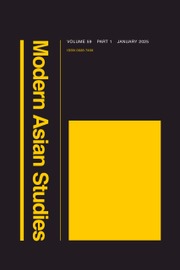Refine listing
Actions for selected content:
Contents
Research Article
Silk Road orientations in Xinjiang archaeology and shifting implications for Eurasian studies
-
- Published online by Cambridge University Press:
- 28 April 2025, pp. 1-32
-
- Article
-
- You have access
- Open access
- HTML
- Export citation
The moment of marriage: Towards a history of temporality in South Asia, circa 1650–1850
-
- Published online by Cambridge University Press:
- 10 March 2025, pp. 33-59
-
- Article
- Export citation
Nudity, obscenity, and the rule of colonial difference in Singapore, 1900s–1930s
-
- Published online by Cambridge University Press:
- 25 February 2025, pp. 60-94
-
- Article
-
- You have access
- Open access
- HTML
- Export citation
From home production to modern mills: Labour allocation, gender, and living strategies of Chinese peasant households, circa 1910s–1930s
-
- Published online by Cambridge University Press:
- 02 April 2025, pp. 95-121
-
- Article
-
- You have access
- Open access
- HTML
- Export citation
Abolitionist parallels: International law and domestic servitude in South China (1900–1940)
-
- Published online by Cambridge University Press:
- 31 March 2025, pp. 122-142
-
- Article
-
- You have access
- Open access
- HTML
- Export citation
The ‘sero-rationalization’ of the Imperial Japanese military, 1926‒1945
-
- Published online by Cambridge University Press:
- 07 May 2025, pp. 143-170
-
- Article
- Export citation
The Manchurian saviour? Re-examining the ‘Otpor Incident’ in imperial and contemporary Japan
-
- Published online by Cambridge University Press:
- 03 June 2025, pp. 171-206
-
- Article
- Export citation
‘The first step towards racial equality’: The Kuroda-Araya engagement and the dream of a transnational non-white alliance
-
- Published online by Cambridge University Press:
- 17 February 2025, pp. 207-233
-
- Article
-
- You have access
- Open access
- HTML
- Export citation
Demographic engineering: Population resettlement in the ethnoterritory of the Chittagong Hill Tracts, Bangladesh
-
- Published online by Cambridge University Press:
- 24 April 2025, pp. 234-264
-
- Article
- Export citation
Songs of Tamil plantation women of Malaya: Contesting memories and histories
-
- Published online by Cambridge University Press:
- 28 February 2025, pp. 265-288
-
- Article
- Export citation
Front Cover (OFC, IFC) and matter
ASS volume 59 issue 1 Cover and Front matter
-
- Published online by Cambridge University Press:
- 17 July 2025, pp. f1-f2
-
- Article
-
- You have access
- Export citation
Back Cover (IBC, OBC) and matter
ASS volume 59 issue 1 Cover and Back matter
-
- Published online by Cambridge University Press:
- 17 July 2025, pp. b1-b2
-
- Article
-
- You have access
- Export citation
